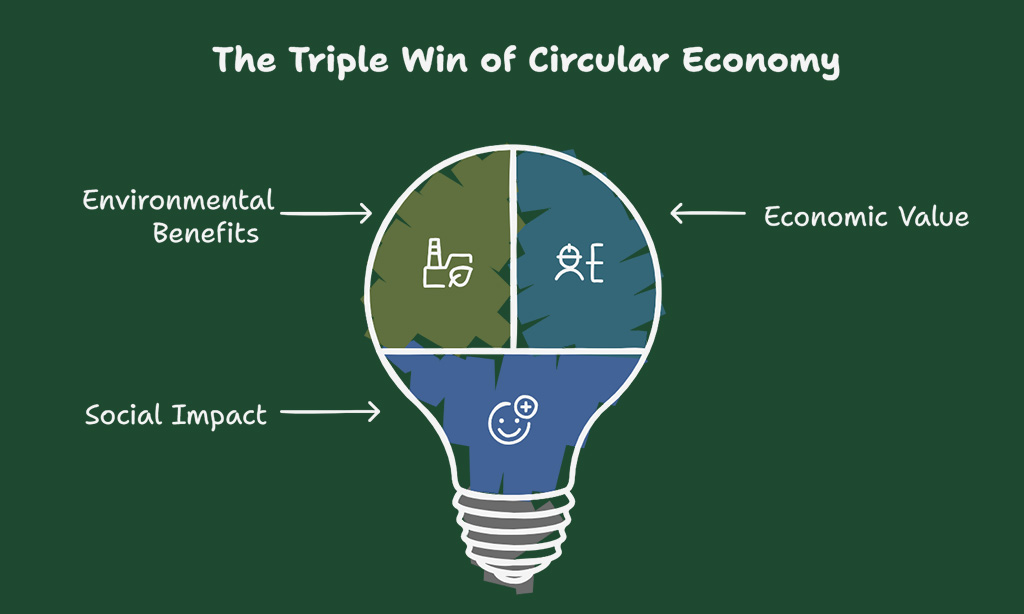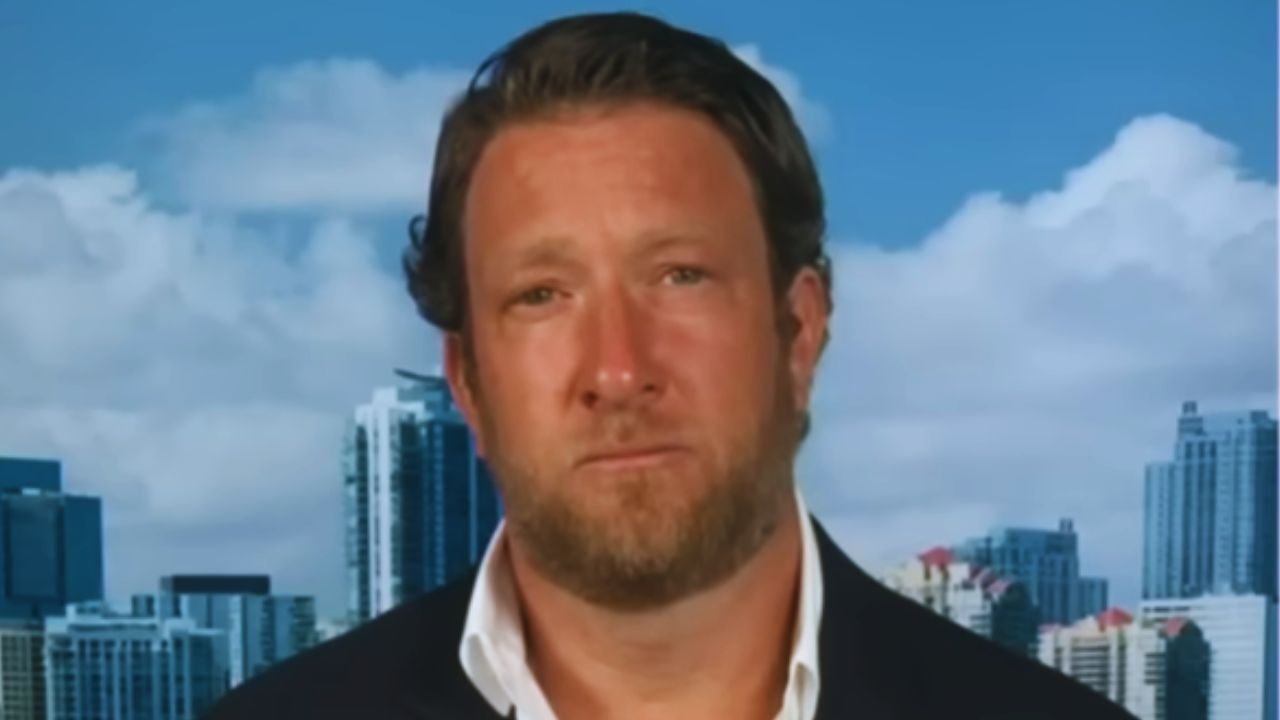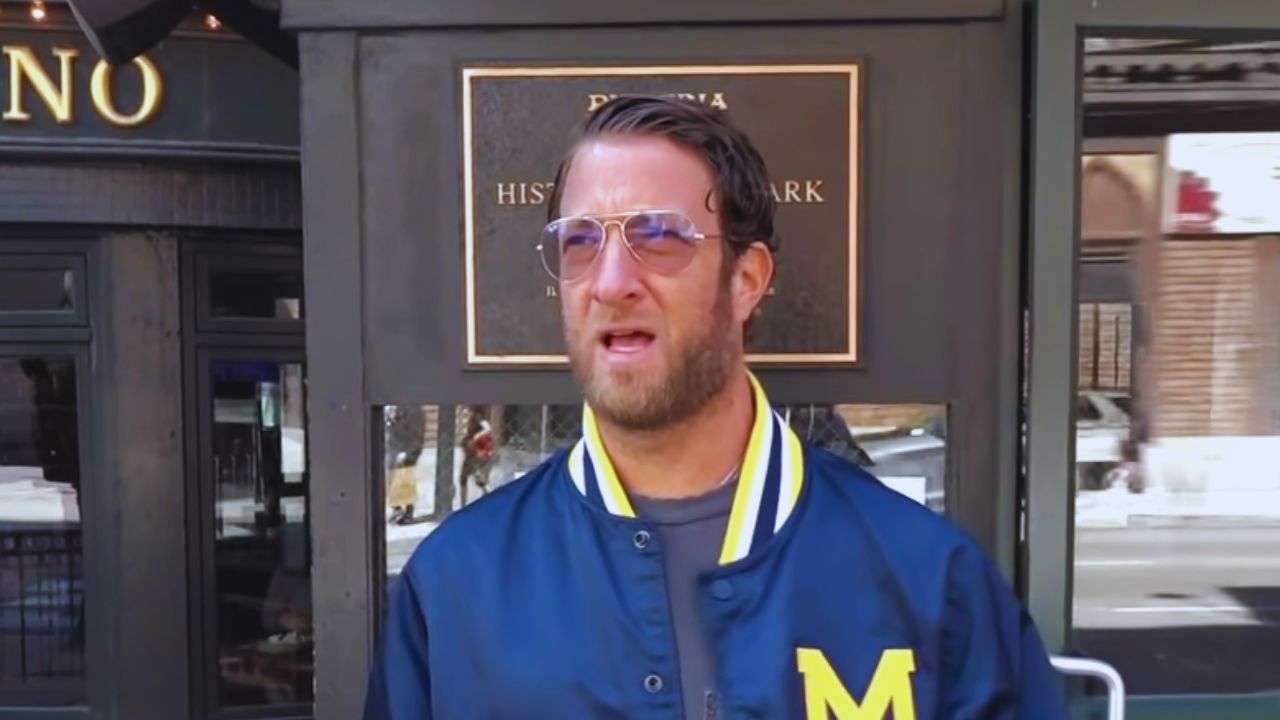Are you tired of seeing trash pile up in landfills? Our throw-away habits hurt our planet more each day. We buy things, use them, and toss them out. This “take-make-waste” system can’t last much longer.
Our world faces big problems like climate change and running out of natural resources.
The circular economy offers a better way. Instead of throwing things away, we keep materials in use. This cuts waste by up to 90% in some cases. The Ellen MacArthur Foundation says this new approach could save businesses $700 billion per year in material costs alone.
This post will show you what the circular economy is and why it matters so much in 2025. You’ll learn how it works, who’s doing it right, and how you can join in. The future depends on it.
Key Takeaways
- The circular economy could save businesses $700 billion per year in material costs by keeping products in a loop instead of throwing them away.
- By 2025, switching to circular models will create 100,000 new jobs in the U.S. and add $1 trillion to the economy each year.
- Only 12% of 300 million tons of plastic made each year gets recycled, showing why we need better systems.
- Companies like Apple, Dell, and Cisco now use recycled parts and take back old products to stop e-waste.
- Circular farming could cut methane gas by 90% and free up land 1.5 times bigger than the EU.
What is a Circular Economy?
Think of a circular economy as a loop where products never become trash. It keeps materials in use through smart design, repair, and recycling – unlike our current “take-make-waste” system that fills landfills.
Key principles of circularity
Circularity works on three main rules that change how we make and use things. First, we design products that don’t create trash or harm our planet. This means making items that can be fixed, reused, or broken down safely.
Second, we keep products and materials working for as long as we can. We fix things instead of tossing them out. We share, rent, and trade items so they don’t sit unused. Third, we help nature heal itself.
We stay away from fossil fuels that hurt our air and soil. We choose materials that grow back, like wood from well-managed forests.
These rules help us move away from our “take-make-waste” habits. In the old way, we grab resources, make stuff, and throw it away. The Ellen MacArthur Foundation shows that this wastes value and harms our world.
With circular thinking, nothing is truly trash. A product at its end becomes food for something new. This cuts down on raw materials we need and stops piles of waste from growing. It also helps fight climate change by lowering greenhouse gas emissions from making new things.
How it differs from the linear economy
The linear economy works like a straight line: take, make, use, throw away. Companies dig up materials, turn them into products, sell them to us, and we toss them in the trash when we’re done.
This wastes valuable resources and fills our landfills. Think about your phone – in a linear system, it ends up as trash after a few years. The circular economy breaks this wasteful pattern.
Instead of a straight line, it forms a loop where materials keep their value. Products get fixed, reused, or taken apart for their parts. Your old phone might become parts for a new one or get fixed and used again.
This big shift helps save our planet’s finite resources and cuts down on waste that hurts our environment.
The Importance of Circular Economy in 2025
The circular economy will be vital in 2025 as our planet faces critical resource limits and growing climate threats. Companies that adopt circular models now will gain a competitive edge while helping cut carbon emissions and create new jobs in recycling and repair sectors.
Addressing climate change and resource scarcity
Our planet faces big problems. The circular economy offers real fixes for climate change and dwindling resources. Did you know one-third of all food made around the world ends up wasted or rotting? This waste adds to greenhouse gas emissions and shows how badly we use what we have.
The fashion world has doubled clothing output in just 15 years, but people wear these clothes half as long as before. This pattern can’t go on. By 2025, we must shift to systems that reuse materials and cut waste.
Recycled materials help save raw inputs and lower carbon output. The EU Green Deal and Paris Agreement push for these changes because they know time is running out.
Smart resource use means less mining, less cutting down trees, and less trash in dumps. Companies now design products to last longer and break down better at the end of their life.
This helps fight biodiversity loss and protects what we need to live. Cities around the world now collect food waste to make compost instead of letting it rot in landfills. Electric vehicles replace gas cars to cut pollution.
These steps matter because they tackle both problems at once – they help the climate while making sure we don’t run out of the stuff we need to live well.
Supporting economic growth and innovation
The shift to a circular economy brings big money gains. In the U.S. alone, this change could add $1 trillion each year by 2025. That’s a lot of cash flowing into new areas! Plus, it will create 100,000 new jobs for people.
These aren’t just any jobs – they’re roles that help our planet while paying the bills. Think of workers who fix things instead of making new stuff, or people who turn trash into treasure.
Companies that jump on board can win big too. Take the chemical industry as an example. By 2030, they could pocket an extra $55 billion yearly just by using materials better. This money comes from smart ideas like making products that last longer or can be fixed easily.
Businesses are finding that waste isn’t really waste – it’s just resources in the wrong place! This fresh thinking sparks new products, services, and ways to work that didn’t exist before.
Key Components of the Circular Economy
The circular economy runs on smart systems that keep materials in use much longer than our old “take-make-waste” model. These systems include better product design that makes fixing things easy, ways to share and reuse products, and methods that turn waste into new resources.
Smarter product design
Smarter product design sits at the heart of the circular economy. Companies like Cisco have made big promises, aiming for 100% circular product design by 2025. This means creating items that last longer, break less, and can be fixed or taken apart when they wear out.
Smart design also cuts waste by using fewer raw materials and picking parts that can be recycled.
Tech giants Apple and Dell show how this works in real life. They now use more recycled stuff in their products and run programs where you can send back old devices. These take-back programs help keep electronic waste out of dumps.
Good design also means less plastic packaging and more parts that can be reused. This helps fight climate change by saving energy and cutting greenhouse gas emissions.
Prolonged product lifecycles
Products last longer in a circular economy. Companies design items to be fixed, not tossed away. Renault shows this by leasing batteries they can rebuild later. This cuts waste and saves money for everyone.
Michelin takes old tires and regrooves them, using only half the raw materials needed for new ones. These smart moves fight waste generation and help our planet.
Making products last is a key part of fixing our waste problem. Think about your phone or clothes. What if they worked for years instead of months? Circular design means fewer things in landfills and less mining for virgin materials.
Products get new life through repair shops, parts sharing, and better building methods. This shift helps cut greenhouse gas emissions while saving resources for future needs.
Efficient resource management
Smart resource use sits at the heart of the circular economy. Today, we waste too much of what we take from the earth. Think about this: from 100 billion tons of resources we use each year, more than 60% turns into waste or harmful gases.
That’s a big problem! Good resource management means tracking materials through their whole life. It means fixing the leaks in our systems where valuable stuff gets lost. Companies now use digital tools to see where their materials go and find ways to keep them in use longer.
Plastic shows how bad we are at managing resources right now. Only 12% of the 300 million tons of plastic made each year gets reused or recycled. The rest fills landfills, burns, or ends up in our oceans.
Better resource plans focus on using less to start with. They also create ways to collect and sort materials so they can become new things. Businesses that get good at this save money on raw materials and waste costs.
They also cut their carbon footprint, which helps fight climate change.
Circular Economy Progress in 2024 and Predictions for 2025
2024 saw major strides in circular economy adoption, with over 50 countries passing new laws to cut plastic waste. We expect 2025 to bring even bigger changes as AI helps track materials better and more companies switch to reusable packaging systems.
Achievements in waste reduction and resource efficiency
The U.S. has made big steps in tackling waste problems. Out of 160 million tons of building waste made each year, more places now recycle it instead of sending it to dumps. Cities like San Francisco and Portland lead the way with programs that turn old concrete into new roads.
Smart waste sorting systems using AI have grown by 35% since last year, helping sort trash faster and better.
Farms are changing how they work too. New circular farming methods cut methane gas by up to 90%. This frees up land space equal to 1.5 times the size of the EU. Companies like Loop and TerraCycle have grown their reusable packaging networks to over 500 stores across America.
The Ellen MacArthur Foundation reports that these efforts saved about 12 million tons of raw materials in the past year alone. This shows real progress in making our supply chains work better with less waste.
Emerging technologies driving circularity
New tech tools are pushing the circular economy forward in 2025. Smart sensors now track products through their life cycle, helping companies know when to repair or recycle items. AI systems sort waste much faster than humans, boosting the current 7.2% material recycling rate.
Digital platforms connect businesses to share unused resources, cutting waste. Blockchain technology lets shoppers scan products to see their full history and how to recycle them properly.
Startups are leading this tech wave with amazing ideas. Some have created special bacteria that break down plastic into useful materials. Others build 3D printers that use recycled plastic to make new products.
These tools tackle real problems like food waste and plastic packaging. While progress has been slow, these technologies offer hope for turning waste into value and helping meet climate goals in the coming years.
Benefits of Adopting a Circular Economy
A circular economy brings a triple win for our planet, wallets, and communities. Moving from take-make-waste to reuse-repair-recycle creates jobs while cutting costs and trash that would fill our oceans and land.
Environmental benefits: reducing emissions and waste
The circular economy cuts waste and fights climate change at its roots. By keeping materials in use longer, we need less new stuff. This means fewer trees cut down and less mining for metals.
Recent studies show that material extraction hurts our planet more than we thought. It drives climate change and kills plants and animals. Circular farming could stop this damage by 2035.
It would free up farm land and cut down on chemicals that harm soil.
Waste piles shrink when we reuse and recycle. Less trash goes to dumps, which means less methane gas escapes into the air. Methane traps heat 25 times better than carbon dioxide. The recycling industry saves energy too.
Making new items from old ones uses less power than starting from scratch. For example, recycled aluminum needs 95% less energy than virgin materials. These small steps add up to big wins for our planet.
Economic value: job creation and cost savings
Going circular puts money in pockets. By 2030, a full shift to circular systems could create 75,000 new jobs in Finland and 500,000 in France alone. Spain might see 400,000 jobs, while the Netherlands could gain 200,000 positions.
These aren’t just any jobs – they span from repair shops to design firms to waste recovery plants. Companies save big too. They spend less on raw stuff when they reuse what they have.
Many firms cut costs by 20% just by fixing their resource use. Think about it: less waste means lower trash bills and cheaper materials. The math is simple – using things longer and smarter saves cash.
Plus, the ILO says green energy growth will add 18 million jobs worldwide. That’s real money and real work from simply being smarter with our stuff.
Social impact: improving quality of life
Circular economies make life better for everyone. People gain access to cleaner air and water as waste drops. Families spend less money when products last longer and cost less to repair.
The health benefits are real too – fewer dumps means fewer toxins in our neighborhoods. Jobs grow in repair shops, recycling centers, and new green businesses. These jobs often pay well and can’t be shipped overseas.
People also connect more with their communities through sharing programs and repair cafes. Instead of tossing broken items, neighbors fix things together. Kids learn skills from older folks who know how to make things last.
This builds stronger towns while cutting waste. The circular model puts people first, not just profits. It creates a world where we all have what we need without using up Earth’s gifts.
Circular Economy in Action: Case Studies
From Amsterdam’s zero-waste neighborhoods to Apple’s recycled iPhone parts, real-world examples show how the circular economy works in daily life – check out these success stories and more in our full case studies section!
Circular economy in cities
Cities across the globe now use trash as treasure. The European Union has big plans to cut landfill waste to just 10% by 2035. This shift helps our planet and saves money too. Many urban areas turn old food, paper, and plastic into new items or energy.
Some cities have set up repair shops where people fix broken things instead of buying new ones. Others have created sharing systems for cars, bikes, and tools so fewer items need to be made.
Smart city leaders know that waste costs money. By finding new uses for old stuff, they create jobs and cut down on trash pickup costs. Some towns now use food scraps to make soil for parks.
Others collect rain water to flush toilets and water plants. These simple steps help fight climate change while making cities nicer places to live. The best part? These ideas work in big cities and small towns alike.
Industry examples: fashion and electronics
Fashion brands are making big changes to cut waste. For Days sells clothes you can send back when worn out. Eileen Fisher takes old garments and makes new ones. These brands show how clothes can have many lives.
In the tech world, big steps are happening too. Cisco plans to make all its products with circular design by 2025. Apple and Dell now use recycled parts in their devices. They also run programs where you can return old products.
These take-back programs stop e-waste from filling landfills. Both fashion and tech firms prove that smart design can save resources and still make money.
How Individuals and Businesses Can Support Circularity
Both people and companies can make big changes by buying better products, cutting down on trash, and backing new green ideas – from fixing old items to joining sharing programs, every small step helps build a world where nothing goes to waste.
Adopting sustainable practices
You can start small with daily choices that cut waste. Swap plastic razors for stainless steel ones like those from Albatross Designs. They offer a Blade Take Back Program that stops metal from ending up in landfills.
Food waste hurts our planet too. Apps like OLIO make a big impact – they’ve shared over 6.5 million food portions that might have been thrown away. These simple steps matter because they save raw materials and reduce trash.
Your actions add up fast!
Try one new green habit each week. Bring cloth bags to stores. Fix broken items instead of buying new ones. Buy less stuff and choose things that last longer. Look for products with less packaging or items made from recycled materials.
The path to a circular economy needs everyone to join in. Your choices push companies to make better products that waste less and help our earth heal.
Investing in circular innovations
Money talks in fixing our planet. Smart companies now put cash into circular ideas that cut waste and save resources. These new business models turn trash into treasure. For example, some firms invest in tech that breaks down old clothes into new fabric.
Others back apps that help people share tools instead of buying new ones. The payoff can be huge! The chemical industry could gain $55 billion in yearly profits by 2030 through circular methods.
That’s not small change.
Funding these bright ideas helps everyone win. Investors get good returns while helping the earth. Circular farming projects could slash methane gas by 90% and free up land 1.5 times bigger than the EU.
Banks and venture funds now have special programs just for green startups. Even regular folks can join in by buying stocks in companies that focus on resource efficiency or waste reduction.
The best part? These investments fight climate change and create jobs at the same time.
Takeaways
The shift to a circular economy marks a turning point in how we make and use stuff. By 2025, this model will help us tackle big problems like climate change and waste. Companies that adopt circular methods now will gain an edge, save money, and create jobs.
Each of us can play a part by buying less, reusing more, and picking products made to last. The time to act is now – our planet’s future depends on all of us working together to close the loop.
FAQs
1. What is a circular economy and how is it different from a linear economy?
A circular economy keeps products and materials in use, unlike a linear economy that makes, uses, and throws away. The Ellen MacArthur Foundation says circular systems cut waste and protect finite resources. Think of it as a loop instead of a straight line.
2. How does the circular economy help fight climate change?
The circular economy cuts greenhouse gas emissions by using fewer raw materials. It supports the Paris Agreement goals through waste reduction and resource efficiency. Plus, circular business models often use renewable energy, which helps reach carbon neutrality.
3. What role do policymakers play in promoting circular economy?
Policymakers create rules that push businesses toward sustainable practices. The European Green Deal and Circular Economy Action Plan are good examples. They set targets for waste management and sustainable consumption that companies must follow.
4. How can businesses adopt circular economic practices?
Businesses can start by looking at their supply chains for waste. They might use FSC-certified materials from sustainable forest management. Some companies design products that last longer or can be fixed easily. Others focus on material recovery after use.
5. What impact does the circular economy have on biodiversity?
Circular systems help stop biodiversity loss by cutting the need for virgin materials. When we take less from nature through sustainable harvesting, we protect animal homes. This helps fix environmental degradation that happens with too much resource use.











































